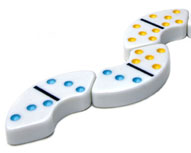
|
About OgreCave and its staff
|

|
by Emma and Allan Sugarbaker
BendominoPublished by Blue Orange Games28 Bendomino game tiles, rules $15.95 This game is featured in our 2007 OgreCave Christmas Gift Guide. When we set forth to start playtesting Bendomino, my daughter and I each had some preconceptions of what a domino game would be like. I thought that any domino-style game would be roughly the same experience – lay down the matching numbered tile, draw another tile, continue. Emma thought dominoes was played by standing them up in a line and knocking them down to the ground. ("Its fun!" Emma said.) As it turns out, we were both a bit right, and also both pleasantly surprised that Bendomino was more than we expected.
Around the bend
Players start by drawing a number of tiles, which varies by the number of participants. The rest of the tiles are placed nearby, face down, to draw from as needed. Starting with the player that drew the highest double tile (6/6, 5/5, etc), players lay tiles on the table so their numbered ends match with those already in place, and build on either end of the chain that forms. If a player can't make a play, he must draw a tile, and either play it or pass his turn. The first player to run out of tiles wins the round, and in multi-round play, each round's winner gains points equal to the numbered tiles his opponents left unplayed. Rounds then continue until a predetermined point value is reached (usually 100). Basic dominoes, more or less. Then the differences start to spice things up. It's all well and good to have a tile that matches the number at the end of the chain, but if your matching tile bends the wrong way, it could curl back and run into an earlier section, a big no-no. We both found ourselves stymied by this multiple times, which only added to the fun. (As a side note, we tried several times to create a closed loop at game's end, but never quite managed it.) The bent tiles also prevent playing off of the side of a doubles tile. Well, you could technically play off the outside edge, but the inner curve is too tight to allow it. Not a huge difference in gameplay from original Dominoes, but significant. Bendomino is also a fun game for parents to use as an educational aid with their kids. The numbers and colors on each bent tile will help kids practice their counting and color recognition. Once kids learn to sight-read number pips up to six, regular dice are no problem, and a whole world of games becomes that much easier to reach. Not that Emma needs the help anymore, of course. "Throw in some times-tables practice," she says, "and then we're talking." A few variant games are detailed in the brief rules pamphlet to help with replay value, as well. Some of these involved starting with a number of tiles already in place, or scoring points each time the tail ends added up to a certain number. Each seemed like a solid optional play method, and we were happy to see them included. It speaks to the elegant simplicity of the game's design that little more was gleaned from playtesting with other adults. A true equal-opportunity game.
Conclusions And yes, you can set them up and knock them down, too. You'll figure it out.
|
||

 That's right: Bendomino adds
the – can't avoid saying it – twist of curved domino tiles. Each
tile bends such that three Bendomino tiles placed end to end will
form a closed circle. The unusual shape forces a different style of
gameplay, to be sure, but at its core, this is still Dominoes.
That's right: Bendomino adds
the – can't avoid saying it – twist of curved domino tiles. Each
tile bends such that three Bendomino tiles placed end to end will
form a closed circle. The unusual shape forces a different style of
gameplay, to be sure, but at its core, this is still Dominoes.